As a car owner, you need properly working tires for a seamless driving experience; however, your tires could still develop problems despite the introduction of the more advanced tubeless tires.
Tire leakage is one of the most common issues for most drivers because it happens unexpectedly. If your tire has a leak around the rim, how do you fix it? Here’s all you need to know!
Tires leak air around the rim because of punctures, tire bead damage, ripped tires, rim problems, or deteriorating valve systems. To fix the leak, drivers have to remove the tire to reseat the bead and reseal, which can be done at home if you have the appropriate equipment or with the help of a mechanic if the inner-tube tires need fixing.
For more information about what causes the tire to leak around the rim, how to fix and prevent it, and how much it will cost to repair your tires, read on!
Identifying a rim tire leak can be difficult to notice at first if your car has a slow leak; however, if your vehicle has a built-in tire-pressure monitor system or TPMS, you’ll get a low-pressure notification because the leak causes the PSI )pounds per square inch) to decrease.
If your tire is leaking, here are the reasons why this could be happening.
Tire Puncture
Once you run over a sharp object, you could puncture your tire. While most drivers assume that the puncture will cause the tire to go flat immediately, this is not usually the case, and the hole might cause a slow two-to-three PSI leak per week.
In some cases, the sharp object like a nail can remain lodged in the tire, which prevents the air from leaking out quickly.
Whether it’s a minor damage or not, you shouldn’t ignore the leak as this may lead to extensive tears and tire damage.
According to The Inflator, approximately seven tire punctures occur every second in the U.S. alone; therefore, this is the first thing you should check for when there’s a leak.
Valve Stem Damage
Valve stems are critical parts of the tire system, and they come in different forms and sizes depending on the tire.
These stems are the tiny protrusions on your tire that you unscrew during inflation; therefore, they need to be in good shape, without any damages or dirt-clogged.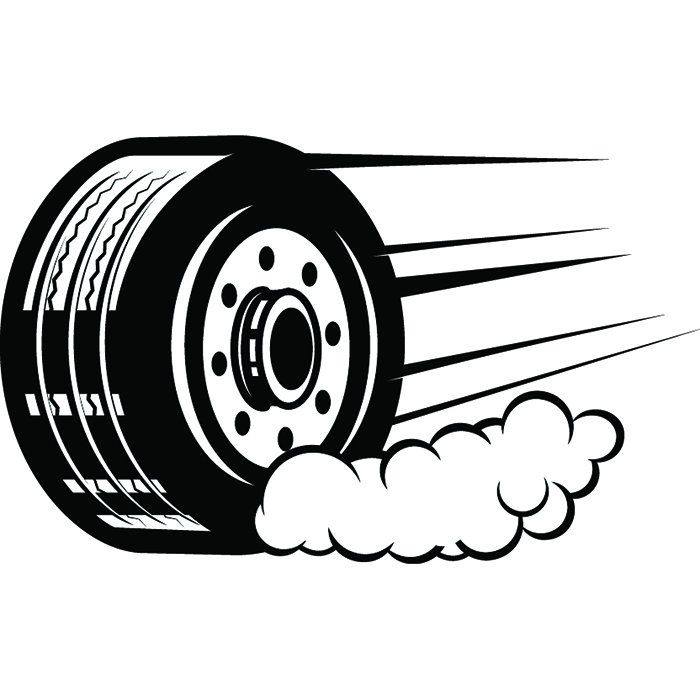
Additionally, when valve stems get exposed to elements over time, they become worn out or corroded, which can cause the air to leak around the rim.
Bead Leak
Tire leaks can also result from bead damage, where the tire seals itself to the rim.
To know whether the bead is the problem, you’ll need to determine how old the tire is because if your tire has dry rot or is older, it may no longer seal properly and have reduced elasticity.
Additionally, beads also get damaged because of a corroded rim or when the tire is mounted or removed using a tire lube.
Your entire wheel gets this type of damage if you regularly hit potholes or bumps at high speed, deforming the wheel’s metal surface, which may cause the tire to pull away.
Keep in mind that if the bead is damaged and you can’t seal the tire to the rim, you have to replace the tire.
Rim Issues
If you are using aluminum or magnesium alloy wheels, your wheels are more susceptible to corrosion, which affects the part where the rim meets the tire bead.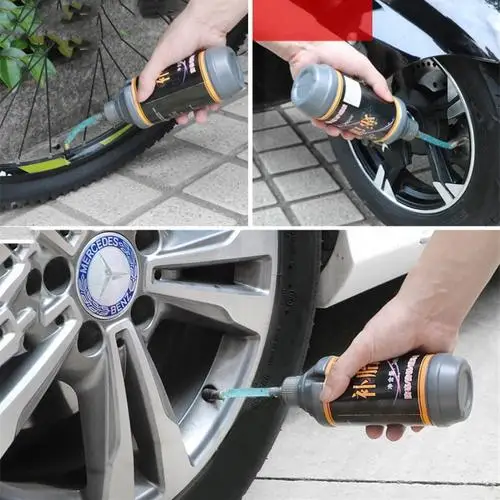
Rim damage can be caused by several causes, especially if you are constantly driving on bad roads with many potholes.
Before installing new tires, ensure your technician checks the bead seal and wheel correctly to confirm that the rims are not corroded.
Furthermore, check for wheel porosity that causes air to leak from the rim due to corrosion, incorrect wheel weights, or poor casting. To fix the leaking issue, avoid injecting a tire sealant and fix the rim first.
Once you discover that your tire is leaking air around the rim, what next? Here are some steps to guide you.
1. Remove The Tire
To identify the cause of the leak, you’ll need to remove the tire and place it on a flat surface with the valve stems facing up.
2. Fill The Tire And Rim With Soapy Water
Add soapy water to your tire; around the outer edge of the rim, the area of the leak will be identifiable through bubbles from the leaking air.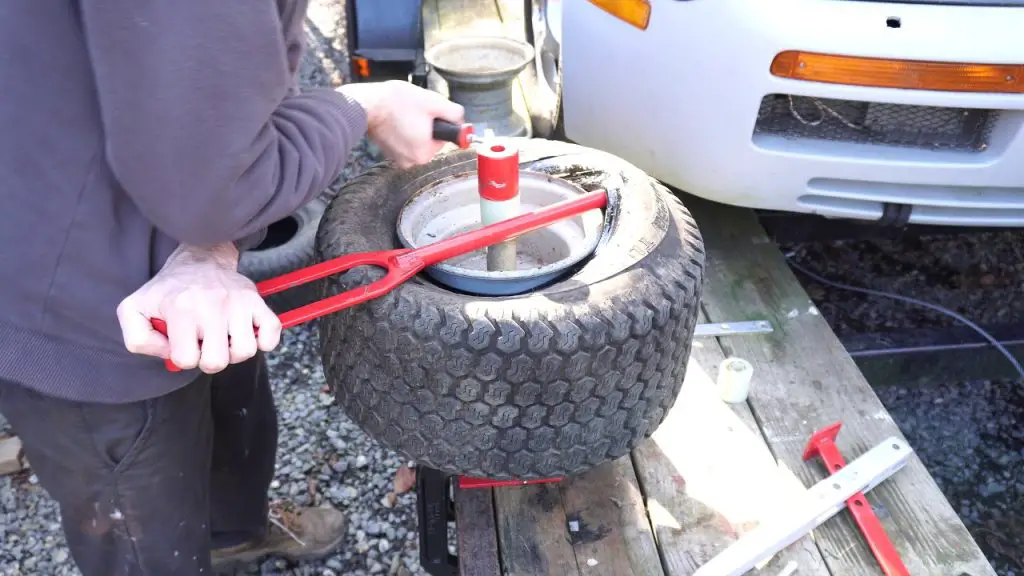 Mark the area and move to the next step.
Mark the area and move to the next step.
3. Release Air From The Valve Stem
After you’ve marked the area, empty the air from your tire by pressing inward on the valve system using the valve removing kit in your car or unscrewing it from the stem.
4. Separate The Tire and Rim
Since the tire and the rim are attached with a seal, you’ll need something heavy like a wood board to separate them.
Use a hammer to hit the wooden plank until the tire’s bead breaks free from the rim.
5. Clean The Tire and Repair
Once the two parts separate, you can stop the leak around the rim by cleaning the tire’s edges with a cloth to remove loose debris and dirt.
After the cleaning is done, you can add some repairing solution to the leakage and start filling the air.
Once you fill the tire with the desired air pressure, you can check again for any leakages using the same process with soapy water.
Fixing a tire rim leak can be expensive or affordable, depending on the leak’s cause and where you get the service done.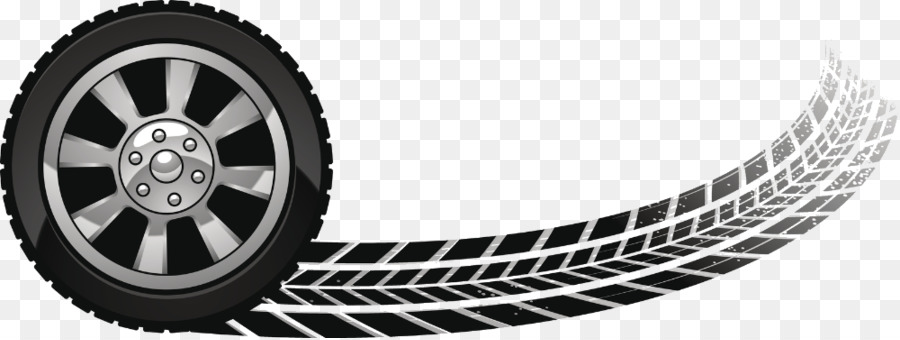
According to customer reviews, if you get the leak repaired at the shop you bought the tire from, you are more likely to get this service for free, but if you go to a different dealer, expect to pay $10-$20.
However, if the leak is because of a damaged rim, you’ll incur more costs which vary greatly depending on the brand.
If you check popular online sites, rims’ prices range from under $25 to $200; therefore, it will cost you more to repair the leakage if you have to replace the rim or entire tire.
To avoid this tire leak, there are some preventive measures that you can take.
Regular Maintenance
As mentioned above, tire leakage can result from valve stems or rims that are dirt clogged; therefore, you need to check your tires regularly.
With more accidents connected to tire blowouts and issues, it’s safer to have your tires checked for any potential problems to prevent leaking around the rim.
Drive Carefully
We have already established that punctures are the number one cause of tire leakage; therefore, if you can, it’s best to avoid situations that could cause punctures.
To achieve this, you should drive more carefully and at recommended speeds, especially on roads with potholes or speed bumps.
Avoid Overinflating Tires
Overinflating tires doesn’t solve a tire leakage problem. Once you identify that air is leaking around the rim, follow the above steps I shared to fix the issue.
However, if you choose to overinflate, the tires will become unstable, rigid, and lose traction when you are driving.
Use A Professional Mechanic
According to the U.S. Tire Manufacturers Association, drivers should supplement their monthly inspections with regular professional tire care.
The check should include wheel balancing, alignment, and tire inspection to protect your tires from leaking air.
To find out more, you can also read our posts on how common are flat tires, underinflated tires, and how long will tires last with bad alignment.
Tires leak air around the rim for several reasons, but luckily this problem can be fixed and prevented.
While it’s possible to fix a leak at home using the kit from your car, you can also enlist the services of a professional mechanic if you spot extensive damage.
I have shared some simple steps that you can take to fix the leak, especially if you are doing it at home.
To avoid these tire problems, regularly check your tires for air pressure and damages at least once a month, consult professional mechanics, and drive carefully to avoid incurring extra repair costs.
Tires are an essential part in automobiles. There is a lot of advancement in tires from traditional vehicles to modern age. From tube tires to tubeless ones, the manufacturers have strived hard to make our long drives smooth. Tubeless tires are the most advanced technology in the market. These tires hold air for longer, and the grip is perfect as well. One of the biggest dilemmas related to tires is leakage. A leaking tire worsens the beautiful journeys in no time. Getting familiar with the fixing process of how to stop a tire from leaking around the rim might assist greatly.
Tubeless tires are the most advanced technology in the market. These tires hold air for longer, and the grip is perfect as well. One of the biggest dilemmas related to tires is leakage. A leaking tire worsens the beautiful journeys in no time. Getting familiar with the fixing process of how to stop a tire from leaking around the rim might assist greatly.
Let us introduce to you “how do you seal a leaking rim” by checking the process of fixing tire bead leak below.
The tire does not work “alone” so you may find that even if the tire is not leaked, the tire is still flatted. So there is a really easy way for you to check if the tire is leaking around the rim or not. Let us show you how to do it!
Get yourself a generic spray bottle. Then make a mix of liquid which includes the dish soap with water, mix well and put it into the bottle. The ratio is 1 soap and 4 water, but you do not need to make it exactly.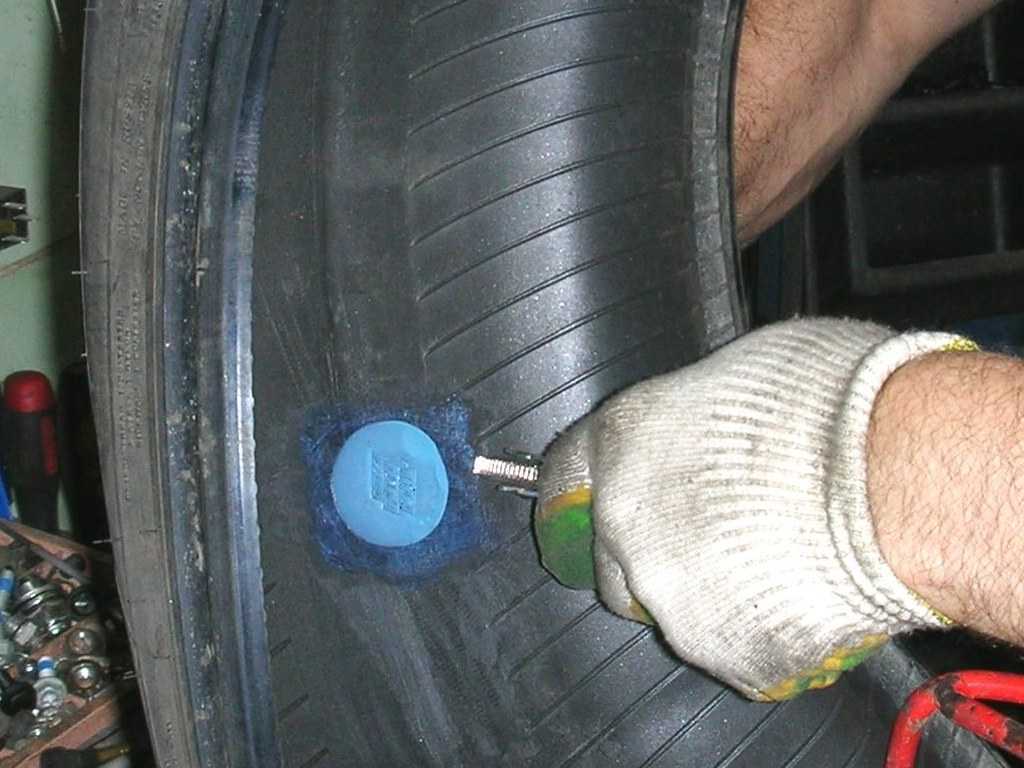 The next step is inflate the tire to the valve caps off and spray solution on the end of the valve as well as so you can see if the valve itself is leaking. If you see the soap bubbles forming anywhere there is a leak. For the small leak, it takes 10-20 minutes to see the change of the tire and the bubbles of the soap.
The next step is inflate the tire to the valve caps off and spray solution on the end of the valve as well as so you can see if the valve itself is leaking. If you see the soap bubbles forming anywhere there is a leak. For the small leak, it takes 10-20 minutes to see the change of the tire and the bubbles of the soap.
This method is easy to check your tire at home and you can do it without experience.
Fixing the leaking tire is not that intricate as it may sound. The changing process is much easier if you have an appropriate equipment kit with you. One might have to visit a mechanic for fixing the inner-tube tires. Fixing tubeless tires is easy with special technique and equipment.
Let’s go through the fixing process of how to stop a tire from leaking around the rim in an automobile.
The first step of how to stop a tire from leaking around the rim is removing the tire and placing it on a flat surface.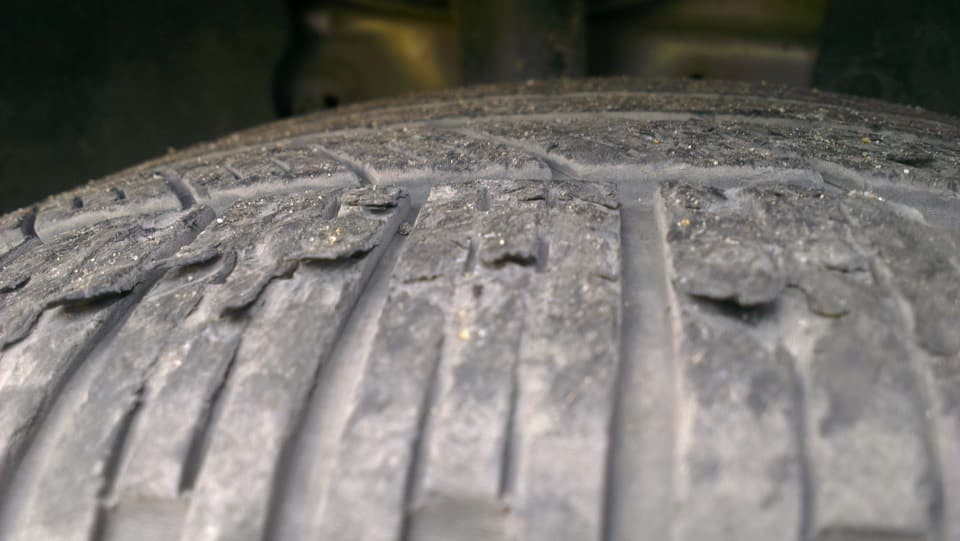 Make sure the air inlet valve is not facing the ground. Examine if there is any leak or hole visible. It will be easier to treat the leakage outside than that of tire leaking around rim seal. Fill the tire and rim attachment with water. The leak area will be identified with bubbles from leaking air. Check both sides of the tire and with simple or soapy water.
Make sure the air inlet valve is not facing the ground. Examine if there is any leak or hole visible. It will be easier to treat the leakage outside than that of tire leaking around rim seal. Fill the tire and rim attachment with water. The leak area will be identified with bubbles from leaking air. Check both sides of the tire and with simple or soapy water.
SEE MORE:
Spot the leakage area on the tire and mark it accordingly. Empty the tire air by pressing the valve inlet with a pin. It is essential to release the air from the tire before treating. There is a valve-removing tool in the car equipment kit as well. Make sure the leaking side of the tire and rim are visible to treat. That’s all you need to do for the second step of how to fix a rim leak.
Procedure to solve problem of tire leaking air around rim Release The Tire-Rim Attachment
Release The Tire-Rim AttachmentTire and rim are attached with a seal. The air inside the tire tightens the seal. You might need something heavy to release the attachment. According to expert’s maintenance tips, a heavy hammer and wooden plank will do the job perfectly. It is essential to remove the tire from the rim if the tire leaking around rim seal is the issue. Hit the plank with the hammer after putting it close to the tire-rim seal.
The final step of how to stop a tire from leaking around the rim is cleaning the edges of the tire with a cloth after releasing the seal. It is easy to press the removed tire with hands and clean it accordingly. Put some repairing solution on the leakage and fill the air again. While the air flows into the tire, make sure to position the tire and rim appropriately. You can check the tire leakage again with water.
>> We have used Japanese cars whose tires are always in perfect condition. Click here!!! <<
Click here!!! <<
Most people who ask how to stop a tire from leaking around the rim wonder how much it costs to fix the leak. If it is the rims, then the wheels have trouble. At the mechanic, the repairman will unmount the tire, clean the rim on the inside, then apply the bead sealer and the unmounted tire. He also changes the valve stem for you. The total cost is around $20 – 30 for one wheel.
The problem is, may shop, instead of fixing the problem from the rim, they write it off as a bad bead or something that they will charge you a lot of money to throw the sealer at the issue. Your car will be fine for one week and the leak will come back to what they were before. Besides, some shops may just grab something around the shop and smooth it out. They try to smooth out the surface where it was leaking then slap on a bunch of bead sealer. So again, the problem is not completely solved.
That’s all about how to stop a tire from leaking around the rim.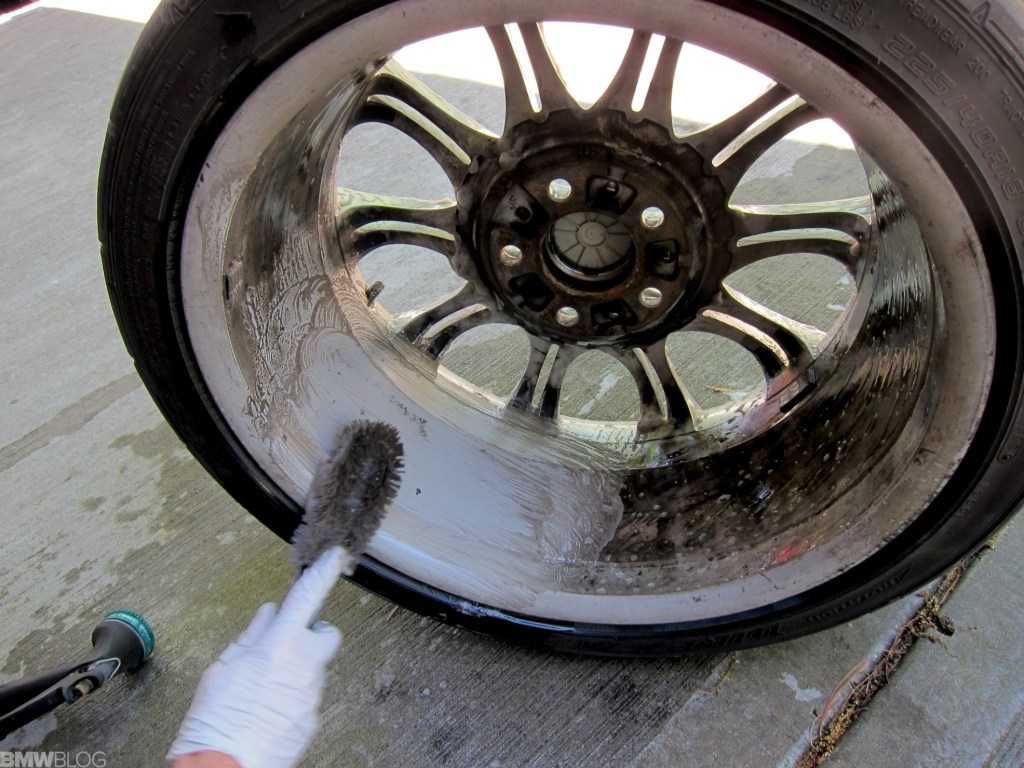 Follow these vital tips and continue your flawless journey on the roads. You can do it yourself at home or if you are not sure that you can do it or not. Bring your car to the trustful garage, tell them that you have a slow leak on the tire and ask them to check the rim. So everything will be on track.
Follow these vital tips and continue your flawless journey on the roads. You can do it yourself at home or if you are not sure that you can do it or not. Bring your car to the trustful garage, tell them that you have a slow leak on the tire and ask them to check the rim. So everything will be on track.
Another season of changing shoes is approaching. And you may remember that on one of the tires after the last winter/summer there is a jamb - a small bump. I don’t want to run to the store for the sake of one new tire. We understand. Or maybe it looks even better if repaired?
Yes, not every wheel that has met with a nail, rebar sticking out of the ground or a sharp stone on the road is considered damaged. Everything, of course, depends on the scale of the damage and its location on the tire itself. Some are easily repaired, while others are simply impossible to do - the tire can only be sent to the trash.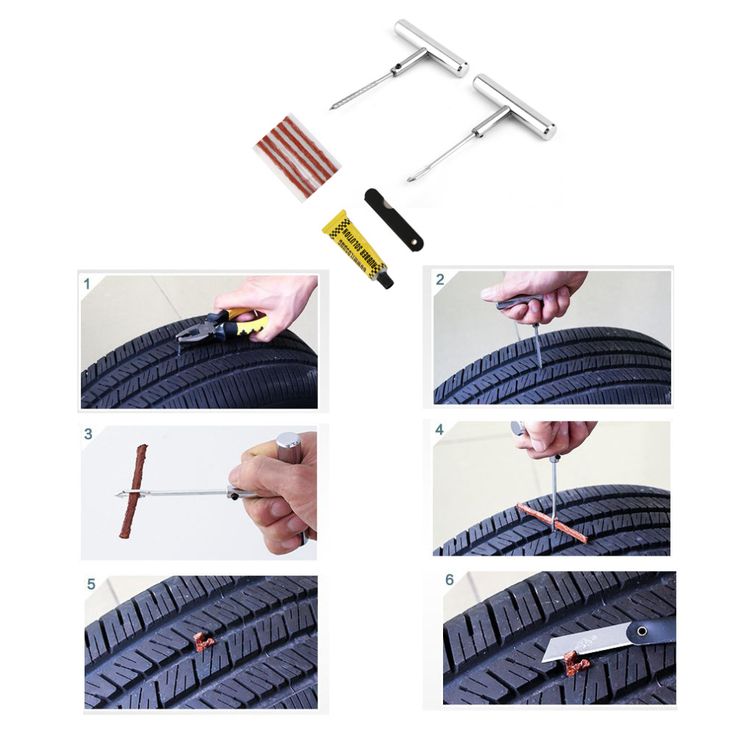
A bulge on a wheel, referred to by drivers as a bump or bulge, is the most common tire sidewall defect. It appears due to a collision with an obstacle or after falling into a pit, more often at high speed. The threads of the sidewall carcass are easily damaged by impact, and the tire at this point can no longer hold the load and air pressure - swelling appears. A small bump sooner or later turns into a big one, and driving with such a defect is dangerous - the wheel can shoot at any moment. At high speed, this is fraught with loss of control, departure from the road and a rollover.
The quality of roads in Kazakhstan contributes to the appearance of bulges on tires
Some types of bulges are repairable, although this is a temporary measure. Not a single patch can restore the factory rigidity. Ideally, change the tire.
Special cord patches can extend the life of a tire with a herniation, even if the swelling has appeared on the tread. The sidewall is a different story. If the swelling appeared at a distance of more than 40 mm from the side, it can be repaired. If not, then the wheel needs to be replaced. Blisters on low profile tires are most often non-repairable.
The sidewall is a different story. If the swelling appeared at a distance of more than 40 mm from the side, it can be repaired. If not, then the wheel needs to be replaced. Blisters on low profile tires are most often non-repairable.
For maximum safety when riding with a repaired bump, insert the tube. This is an inexpensive and reliable solution. On our market, you can find cameras made in China and Russia, the latter are slightly more expensive, but also of better quality.
The elimination of a side cut is a serious operation, therefore, as in the case of a bump, you will have to go to the professionals. We need cord patches, fortunately in our time they are of different sizes and with a different number of layers. And if you do it wisely, then you can't do without special tools and vulcanization.
A cut, by the way, cannot be healed in all cases. If the gap is in the shoulder area of the tire, it is unlikely that anyone will undertake to repair it, since no guarantees can be given here.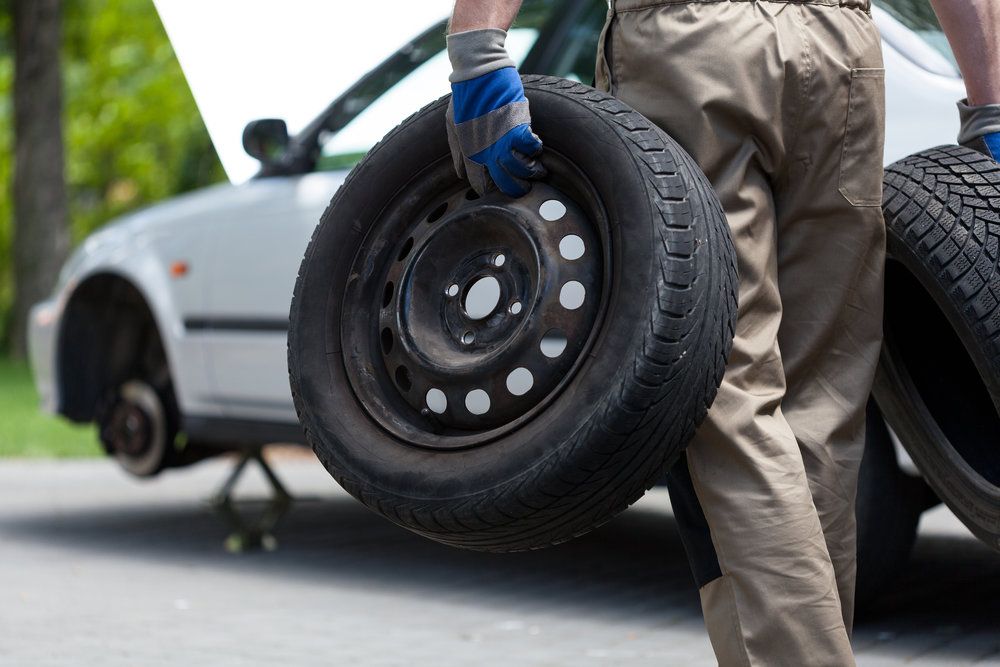 However, our Kulibins take on even the most difficult cases, cutting out parts of the sidewalls from the tires and even weaving the cord on their own.
However, our Kulibins take on even the most difficult cases, cutting out parts of the sidewalls from the tires and even weaving the cord on their own.
Tire overhaul. We would not put such a wheel on ourselves
Low profile tires can be repaired, but more difficult. A tear in the sidewall is easier to seal on tires with a medium or high profile.
Sometimes a cut is confused with a pluck. This is when the outer layer of the sidewall caught on something sharp, a tear formed, but the frame itself remained intact. There is nothing wrong with that, although the drivers at the tire fitting company successfully repair the cut, for which they take it accordingly.
If a piece of rubber remains on the sidewall, then glue it with ordinary superglue (101st). If it came off, then it is better to cover it with raw rubber and vulcanize. Leaving the pluck bare is not recommended, because the tire carcass, often consisting of a metal cord, will quickly corrode.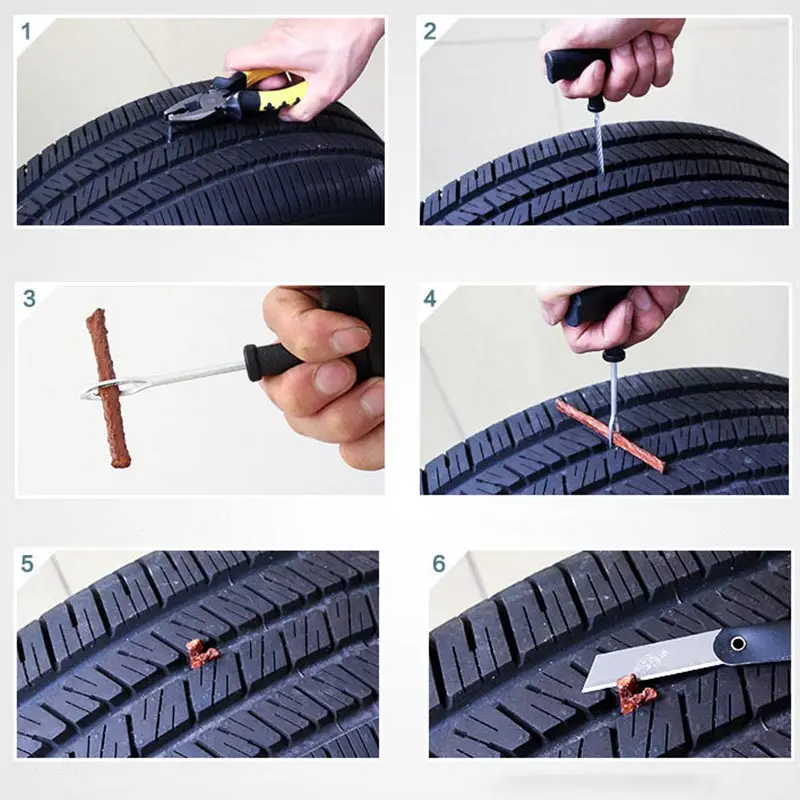
In Europe, defective or used tires are perforated before being sent for scrap to prevent their resale and possible operation. But they don’t know that we have such holes on the sidewall patched once or twice
Cuts and hernias are not the only possible damage to the side of the tire. You can also spoil the side ring, in the process of changing shoes, for example. If it’s for garlic, then such a tire is already dangerous. Sooner or later, the tire pressure and the load in motion will start to squeeze the rubber off the rim - a wheel explosion can occur.
This ailment is repaired if the wire ring - the base - is intact. There are no special technologies and materials to correct this particular problem, but most often craftsmen use a two-component composition for chemical (also called cold) vulcanization. After mixing, the mass is pressed into a fat-free damage. Compound manufacturers recommend waiting 72 hours before mounting a tire.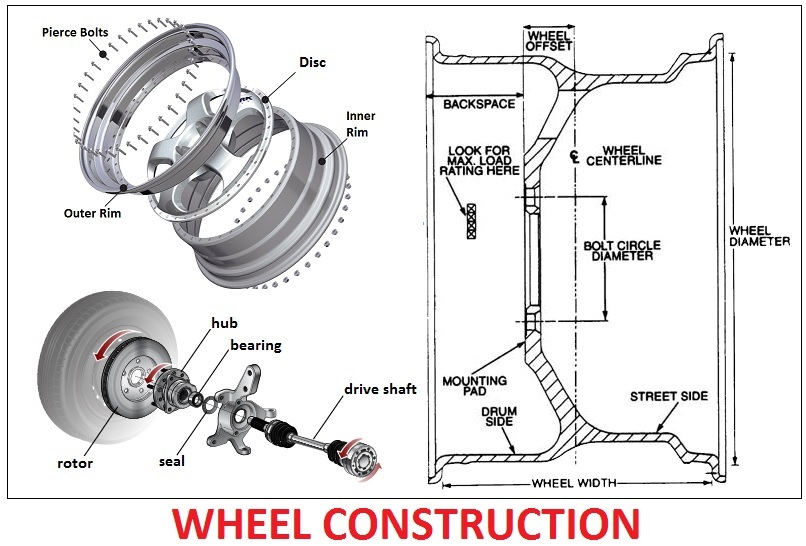 Of course, our masters do not pay attention to this condition - they put the tire right away. And it’s good if the wheel is flat because of this at night in the parking lot, and not on the road.
Of course, our masters do not pay attention to this condition - they put the tire right away. And it’s good if the wheel is flat because of this at night in the parking lot, and not on the road.
If the side ring tears are barely noticeable, but the wheel still deflates, then you can use a special liquid - a bead seal designed to seal a tubeless tire.
These seals have been used in motorsport for some time. In particular, in the American Formula D Drift Series, drivers used compounds to keep the tire on the rim even with minimal tire pressure. Now they are banned.
Pay attention to the left rear wheel of the Nissan Silvia S13. Due to too low pressure, it was literally taken off the disk under load
Every schoolchild has faced this problem when patching the inner tube of his bike after hitting something sharp. Repairing a car tire puncture with your own hands will also not be difficult even on the road. But for this you will need a pump (or compressor) and a universal tire repair kit with harnesses.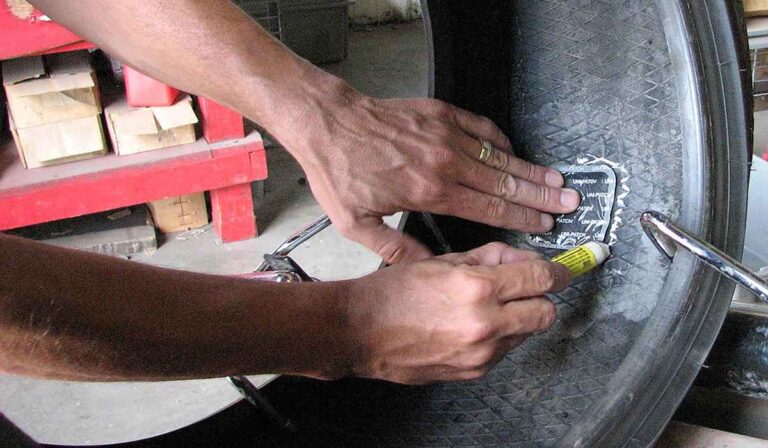 All this is sold at any car market or gas station.
All this is sold at any car market or gas station.
Repairing a tire on the side of the road with harnesses
The process is simple. If we are talking about the front wheels, then in most cases the wheel can not even be removed, it is enough to turn the steering wheel in the right direction, find the puncture site and carry out repairs. First, the hole is cleaned with a helical awl from the set. The tourniquet itself is smeared with glue and tucked into the eye of the awl, after which it is inserted into the tire hole. With a sharp movement, the tool is removed, and the tourniquet remains in place and clogs the hole. The tails are cut with a knife, but not at the root, it is recommended to leave about 20 mm. The tire is inflated and checked.
Sometimes a nail or self-tapping screw clogs the hole by itself, remaining in it. If you see a hat in a tread, do not rush to pull it out. While the pressure is holding, move to vulcanize.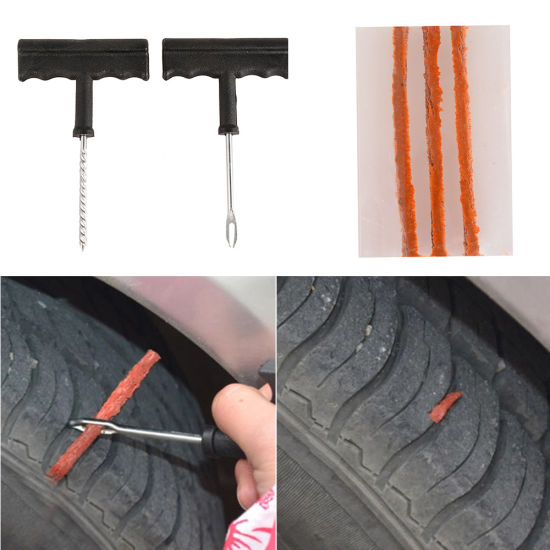 And sometimes they drive with a screw in a tire for weeks.
And sometimes they drive with a screw in a tire for weeks.
Repair of a puncture at a tire shop
Punctures are also repaired with harnesses at a specialized service, although among professionals such repairs are not considered long-term. After a few months, the flagella dry out and can let air through. There are more advanced methods like cold and hot vulcanization. The latter is more reliable. In this case, the hole is sealed with an elastic patch, and the funnel from a foreign object is filled with a special compound. After that, a vulcanizer is put on the tire, it heats up the rubber and solders it.
In addition to the plaster, the puncture is also repaired with special cord fungi. Craftsmen process the puncture site: drill it and treat the surface with a tool to roughen it. Then the repair area is lubricated with glue (it is also called cement) and a fungus is introduced. This is done from the inside of the tire. The cap of the fungus is rolled, and the excess legs are simply cut off from the outside.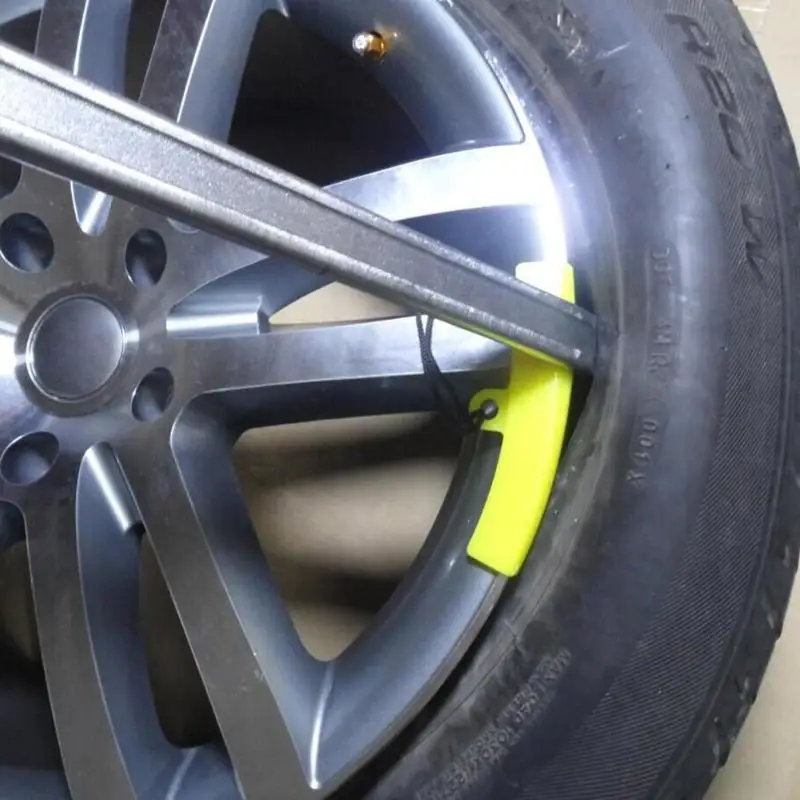
Puncture repair with sealant
With the advent of tubeless wheels, and later run flat tires, many automakers began to abandon spare wheels. Instead, repair kits with compressors are supplied with the machines. A repair kit is essentially a bottle of pressurized sealant. Later, such spray cans began to appear on the shelves of ordinary car dealerships.
This method has not taken root in the CIS, because the condition of the roads makes it necessary to have at least a stowaway in the kit, but it can also be considered as a method of repair on the road.
The car must be jacked up and sealant must be pumped into the damaged wheel through the nipple. Next, you should spin the wheel, then pump it up, lower the car and drive a few hundred meters. If the tire tightness has not been restored, repeat the procedure.
For commercial vehicles, cutting the tread with a special device (regrower) is a common thing. Moreover, such tire retreading is provided by the factory (marked REGROOVABLE on the sidewall) to increase the service life. But there are entrepreneurs who undertake to deepen the grooves in tires for passenger cars. But they are not intended for such an operation. Often used tires for sale are “refreshed” in this way. Be careful!
What is the threat?
The worst option is that the retreaded tire will shoot out on the road, as the master can damage the undertread layer when deepening the grooves. Such a tire will not be able to hold pressure at some point. There will be a boom! At best, the tire will indeed last a little longer, but is the game worth the candle? We think it's not worth it.
How is cutting done?
A regrower is used to cut the tread. Roughly speaking, this is a large soldering iron with interchangeable tips of various shapes. It goes through rubber like a knife through butter.
It goes through rubber like a knife through butter.
If the tire is for passenger cars, then it is worth taking on a regrower only in one case - when part of the tread pattern was welded with "new" rubber during repair. This is where threading comes in handy in order to restore the grooves and symmetry of the tread.
Vehicle operation is prohibited if:
- tires have a residual tread height of less than 1.6 mm;
- tires have punctures, cuts, ruptures that expose the cord, as well as delamination of the carcass, delamination of the tread and sidewall;
- tires in size or load capacity do not match the car model;
- tires of various sizes, designs (radial, diagonal, chamber, tubeless), models, with different tread patterns, winter and summer, studded and non-studded, new and restored, are installed on one axle of the car;
- Tires retreaded according to the second repair class are installed on the front axle.
What is a second class repair?
This is the case when the carcass of the tire is restored after serious damage. A side cut (or tear) is a serious damage to the tire carcass.
If you find a flat tire, stop in a safe place, turn on the warning light, assess visibility and, if necessary, set a warning triangle: The Highway Code requires a distance of at least 15 meters from the car in a built-up area and at least 30 meters from the car outside the settlement.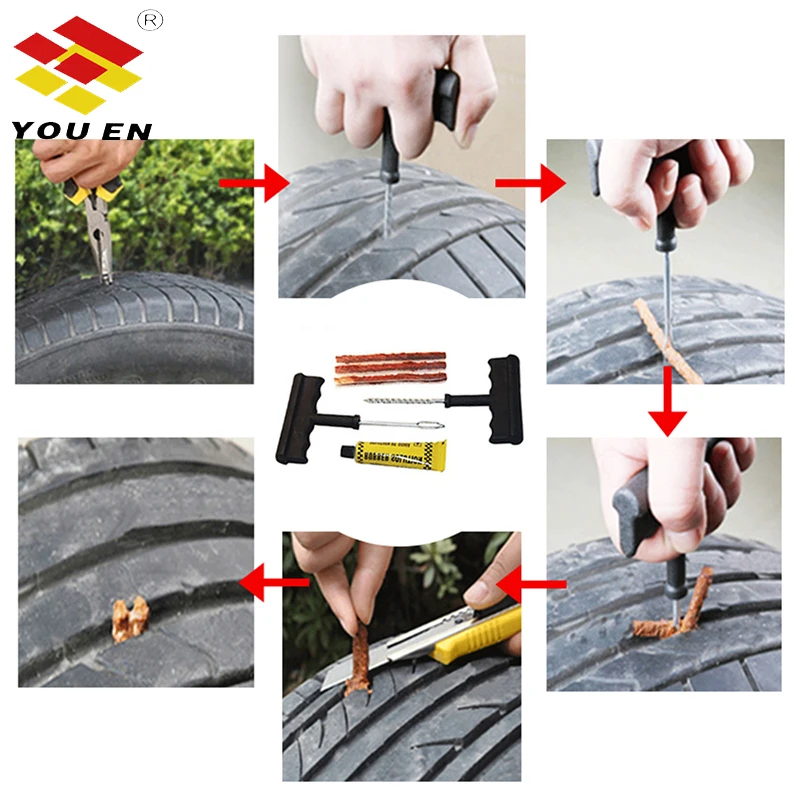 When choosing where to stop, consider the amount of space on the side of the vehicle that is needed to deal with a flat tire. Do not stop on the road or in places where stopping is prohibited: a punctured tire can cause a sudden stop, but you can drive several tens of meters to find a safe and convenient place to stop. At night or in conditions of limited visibility (for example, in fog or rain), it is mandatory to wear a vest with reflective elements - this is required by section 2.3.4 of the Highway Code and common sense.
When choosing where to stop, consider the amount of space on the side of the vehicle that is needed to deal with a flat tire. Do not stop on the road or in places where stopping is prohibited: a punctured tire can cause a sudden stop, but you can drive several tens of meters to find a safe and convenient place to stop. At night or in conditions of limited visibility (for example, in fog or rain), it is mandatory to wear a vest with reflective elements - this is required by section 2.3.4 of the Highway Code and common sense.
Now we can start working on the wheel. We will look at several options in turn, and then proceed to repair the damaged tire.
The most obvious solution to a flat tire is to replace it. If you have a spare tire that you know is in good condition, it's best to have it installed and have the punctured tire repaired at a car repair shop - it's much safer and better than doing it yourself.
Flat tire - punctured If you don't have a working spare but you do have an inflator or compressor, you can assess the damage to the tire and try to re-inflate it to get to a tire shop. The best place to start looking for air leaks is at the valve (aka "nipple" or "nipple"): a failed nipple is often the cause of a tire puncture. It's easy to check: unscrew the protective cap (if there is one), pour water on it (or suck on it, as in childhood): air bubbles will let you know there is a leak. In this case, you can try to replace the spool valve by unscrewing it and screwing in a new one, but if a new valve is not available, and also at the nearest store, you can try just unscrewing and screwing it back. Whether it helps or not, you should visit a tire shop to have the valve core or entire valve replaced.
If the valve is tight and the tire is flat, it is most likely a puncture. The easiest way to find a puncture, if there are no foreign bodies, is to pour water on the tire and check its surface: damage will be detected by air bubbles. However, often the cause of a puncture can be found along with it: a screw, nail or other random object sticking out of the wheel will clearly indicate the place of depressurization. In this case, there is no need to immediately remove the foreign body: it will partially seal the hole, and if the pressure loss is slow, you can try to inflate the tire and go to the tire shop.
The same applies to wheels that leak around the rim or due to a faulty valve. Usually the air deflates slowly, and you can inflate the tire and drive to the repair shop. By the way, rim leaks can occur as a result of deformation of the rim upon impact - for example, when hitting a pothole with sharp edges. Such situations can lead to damage to both the rim and the tire bead, in which case the rim must be straightened and the tire repaired or even replaced. To avoid rim leakage, check the rim every time you change tires. Loss of tightness is caused either by corrosion or disk deformation, and not only steel disks are subject to corrosion, but also disks made of light alloys. Therefore, if you see paint blistering or rust on the rim, seal the tires with rim sealant: when changing tires, it will be cheaper than removing and reinstalling the tire to fix a leak on the rim.
If you find a puncture, but there are no foreign bodies in it, and you do not have a spare tire and tire repair kits, there is another popular method of temporary "repair". You can screw a self-tapping screw into the hole found - if you have one, of course. In extreme cases, you can look for a self-tapping screw in the car, unscrewing it from some interior detail. This method is not reliable: it is unlikely to completely seal the wheel, but at least it will help you get to the nearest tire shop.
Some other useful tips. If the tire is completely flat, it's easier to inflate it without the spool: unscrew the spool, then inflate the tire and quickly screw it back on. The fact is that the spool itself creates resistance to the compressor when inflated, and if the flat tire does not fit snugly against the disk, the performance of a conventional magazine compressor may not be enough, and the absence of a spool helps to increase air flow and facilitate the operation of the compressor.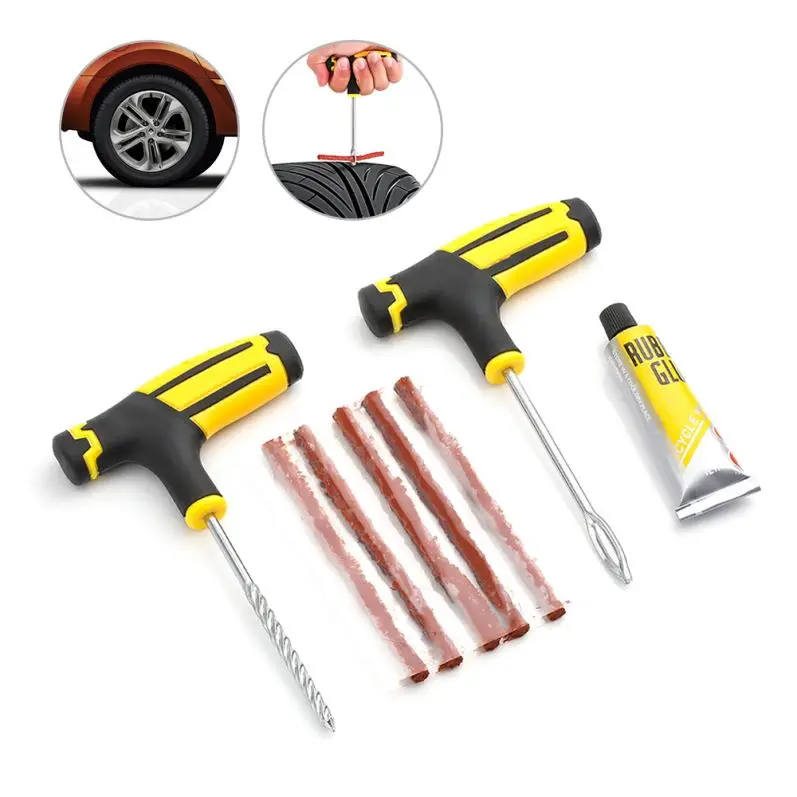 If that still doesn't help, you can raise the car by letting the punctured tire sag: this will improve the contact between the tire and the rim and make it more likely to inflate the tire.
If that still doesn't help, you can raise the car by letting the punctured tire sag: this will improve the contact between the tire and the rim and make it more likely to inflate the tire.
Now it's time to consider repairing tires yourself with special materials that you can carry with you or, if you have a punctured tire in the city, buy at a local auto repair shop.
The most common, cheap and easy DIY repair method is to install a raw rubber band. The kit includes an abrasive awl to expand the hole in the tire and improve the contact of the repair tourniquet with the edges, a needle for installing the tourniquet and glue to fix it when sealing a puncture. When choosing a repair kit in the store, you should pay attention to the following points:

The wiring harness is installed in the following order. First, the hole found is expanded with an abrasive awl - it must be inserted and pulled out several times at the puncture site. Then a tourniquet is inserted into the eye of the needle and glue is applied to it. Then insert the needle with the tourniquet into the hole in the tire and quickly pull it out so that the tourniquet remains in the hole and the needle comes out without it. After that, simply cut the end of the harness so that it is flush with the tire and inflate the wheel.
The advantage of applying a tourniquet is that it is quite decent in terms of reliability, simplicity and cheapness. You can ride a repaired tire for a long time, and if the repair site starts to leak, you can replace the harness or have the tire repaired by professionals. The disadvantages include the possibility of damage to the tire cord during installation and less reliability compared to repair methods in a "full" tire shop.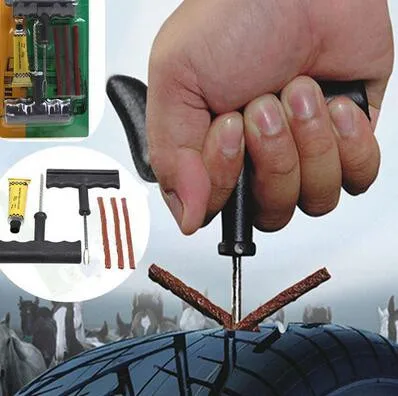 Strictly speaking, the harness is still a temporary repair, so if you can pump up the wheel and go to a tire shop, it's better not to enlarge the hole in the tire and go to the professionals.
Strictly speaking, the harness is still a temporary repair, so if you can pump up the wheel and go to a tire shop, it's better not to enlarge the hole in the tire and go to the professionals.
The second repair option is liquid aerosol sealants sold in cans. To repair a punctured tire with sealant, it is necessary to remove the foreign body from the puncture site, then pour the sealant into the wheel through the valve, turn it to distribute the compound inside the tire, inflate the wheel and drive several kilometers at low speed for the final even distribution of the sealant.
The advantages of this repair include its simplicity and less labor intensity compared to installing the strapping. However, it has its drawbacks: the larger the hole, the greater the chance that the sealant will not be able to patch it, and, in addition, such repairs can affect the balance of the wheel. Compared to a harness, it can be considered even less reliable and preferable, but simpler.
If you fit a spare tire and take the wheel to a tire shop, you may also be offered several repair options. Consider the most popular of them with an indication of the advantages and disadvantages.
1. The first way to repair is the same harness installation as described above. As we remember, the tourniquet refers to emergency repairs, so among professional tire fitters this method is considered bad form, but many workshops do not exclude it from the list of their services. The advantages and disadvantages are the same here: it will be the fastest, easiest and cheapest repair, but less reliable than other methods. It should be chosen in cases where the price and / or speed of treatment is more important to you than anything else. If quality is a priority, you might be better off using the options below.
2. The second option for repairing a punctured tire is to patch the inside of the tire, known as cold vulcanization. The tire is removed from the rim, the area around the puncture is cleaned with an abrasive and sealed with a plaster. This is a better repair solution than a harness, which is much more reliable and durable, especially in side punctures when the tire tread is not very thick and the sidewall is thinner than thick. The only downside is the higher cost: in addition to the tire repair itself, you will have to pay for the removal and installation of the wheel (or do it yourself), mounting the tire and balancing it.
The tire is removed from the rim, the area around the puncture is cleaned with an abrasive and sealed with a plaster. This is a better repair solution than a harness, which is much more reliable and durable, especially in side punctures when the tire tread is not very thick and the sidewall is thinner than thick. The only downside is the higher cost: in addition to the tire repair itself, you will have to pay for the removal and installation of the wheel (or do it yourself), mounting the tire and balancing it.
3. The third option is a "complex" of the first and second: installation of the so-called repair "mushroom". The “cap” of the mushroom is a patch, and the “leg” is pushed from the inside of the tire out. After the patch is glued into place, we cut off the excess part of the stem, similar to a tourniquet. This seals not only the inside of the tire, but the hole itself. The advantages and disadvantages of this repair method are basically the same as patching.
4 . An extreme "emergency" way to repair a punctured tire is to install an inner tube. This method is usually used for tires that are no longer worth repairing, or for "safety" after repairing a puncture joint. It is important to know that almost all modern tires are tubeless, so the inner tube should not be used for a long time, and you should not ride a wheel repaired in this way. Threading the inner tube is a temporary solution until you have to buy a new tire and sometimes you can keep it as a spare. Therefore, this repair method can be kept in mind as a fallback option.
We have deliberately left out of the scope of this text such methods as combined repair of tires and patches and hot vulcanization. The first is used quite rarely and for specific types of damage, and it is quite easy to find out about its existence. The second method is used to repair severe side cuts and is not only rare, but also quite expensive.